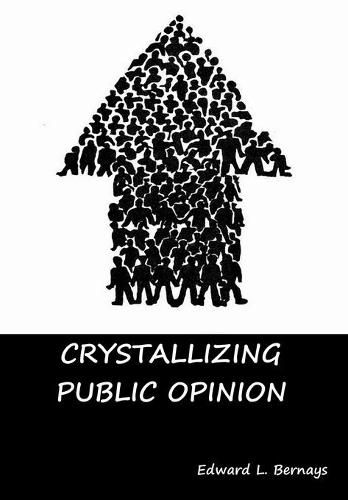Readings Newsletter
Become a Readings Member to make your shopping experience even easier.
Sign in or sign up for free!
You’re not far away from qualifying for FREE standard shipping within Australia
You’ve qualified for FREE standard shipping within Australia
The cart is loading…






This title is printed to order. This book may have been self-published. If so, we cannot guarantee the quality of the content. In the main most books will have gone through the editing process however some may not. We therefore suggest that you be aware of this before ordering this book. If in doubt check either the author or publisher’s details as we are unable to accept any returns unless they are faulty. Please contact us if you have any questions.
Crystallizing Public Opinion is a book written by Edward Bernays and published in 1923. It is perhaps the first book to define and explain the field of public relations.
Bernays defines the counsel on public relations, as, more than a press agent, someone who can create a useful symbolic linkage among the masses. Appropriate messages should be crafted based on careful study of group psychology, and disseminated by not merely purveying but actually creating news.
He gives examples from his early career and cites ideas from theorists including Walter Lippmann and Wilfred Trotter.
Crystallizing Public Opinion appeared the year after Lippmann’s Public Opinion and can be construed as an application of Lippman’s principles to the active manipulation of public opinion. Whereas Lippmann saw a bigger role for government in steering public opinion, Bernays focused on the corporation and its public relations attache.
Professor Sue Curry Jansen argues that Bernays distorted Lippman’s work (and that public relations historians such as Stuart Ewen and Larry Tye have uncritically recapitulated Bernays on this point). She writes that Public Opinion is an analysis of the constraints on rationality which confront a democratic society and that Bernays systematically inverts Lippmann’s critique into an apology for public relations by selectively and deceptively quoting him in support of positions that Lippmann clearly rejects. Whereas Lippmann treated the stereotype as a sort of blind spot, or obstacle to rational thinking, Bernays viewed it as a great aid to the public relations counsel despite being not necessarily truthful . She also finds that Crystallizing Public Opinion sometimes attributions quotations to Lippmann which do not match the text of Public Opinion at all.
$9.00 standard shipping within Australia
FREE standard shipping within Australia for orders over $100.00
Express & International shipping calculated at checkout
This title is printed to order. This book may have been self-published. If so, we cannot guarantee the quality of the content. In the main most books will have gone through the editing process however some may not. We therefore suggest that you be aware of this before ordering this book. If in doubt check either the author or publisher’s details as we are unable to accept any returns unless they are faulty. Please contact us if you have any questions.
Crystallizing Public Opinion is a book written by Edward Bernays and published in 1923. It is perhaps the first book to define and explain the field of public relations.
Bernays defines the counsel on public relations, as, more than a press agent, someone who can create a useful symbolic linkage among the masses. Appropriate messages should be crafted based on careful study of group psychology, and disseminated by not merely purveying but actually creating news.
He gives examples from his early career and cites ideas from theorists including Walter Lippmann and Wilfred Trotter.
Crystallizing Public Opinion appeared the year after Lippmann’s Public Opinion and can be construed as an application of Lippman’s principles to the active manipulation of public opinion. Whereas Lippmann saw a bigger role for government in steering public opinion, Bernays focused on the corporation and its public relations attache.
Professor Sue Curry Jansen argues that Bernays distorted Lippman’s work (and that public relations historians such as Stuart Ewen and Larry Tye have uncritically recapitulated Bernays on this point). She writes that Public Opinion is an analysis of the constraints on rationality which confront a democratic society and that Bernays systematically inverts Lippmann’s critique into an apology for public relations by selectively and deceptively quoting him in support of positions that Lippmann clearly rejects. Whereas Lippmann treated the stereotype as a sort of blind spot, or obstacle to rational thinking, Bernays viewed it as a great aid to the public relations counsel despite being not necessarily truthful . She also finds that Crystallizing Public Opinion sometimes attributions quotations to Lippmann which do not match the text of Public Opinion at all.